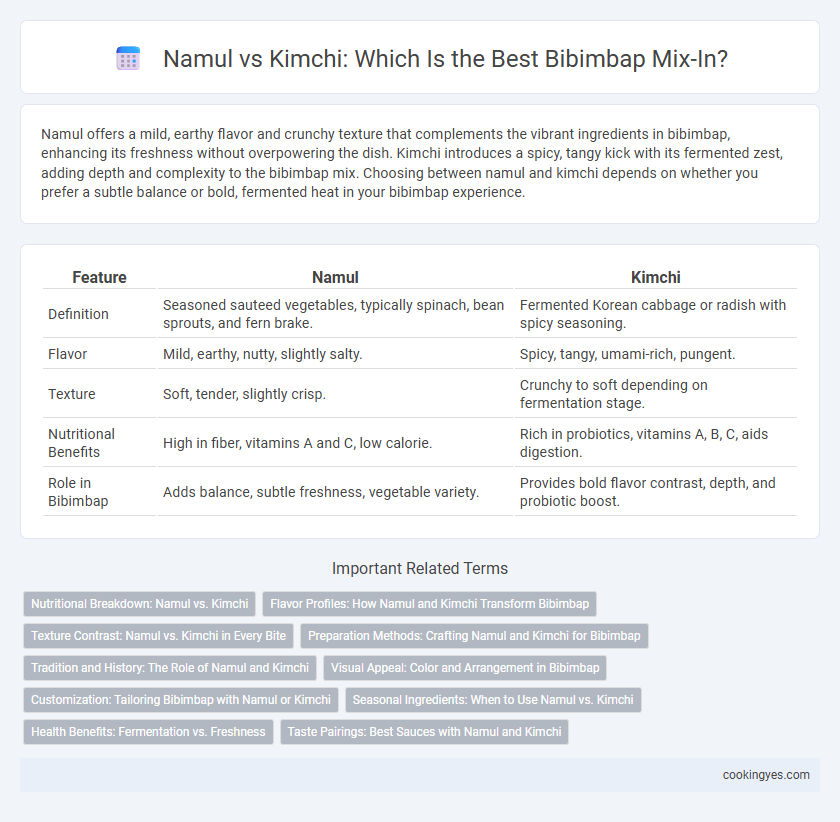Namul offers a mild, earthy flavor and crunchy texture that complements the vibrant ingredients in bibimbap, enhancing its freshness without overpowering the dish. Kimchi introduces a spicy, tangy kick with its fermented zest, adding depth and complexity to the bibimbap mix. Choosing between namul and kimchi depends on whether you prefer a subtle balance or bold, fermented heat in your bibimbap experience.
Table of Comparison
| Feature | Namul | Kimchi |
|---|---|---|
| Definition | Seasoned sauteed vegetables, typically spinach, bean sprouts, and fern brake. | Fermented Korean cabbage or radish with spicy seasoning. |
| Flavor | Mild, earthy, nutty, slightly salty. | Spicy, tangy, umami-rich, pungent. |
| Texture | Soft, tender, slightly crisp. | Crunchy to soft depending on fermentation stage. |
| Nutritional Benefits | High in fiber, vitamins A and C, low calorie. | Rich in probiotics, vitamins A, B, C, aids digestion. |
| Role in Bibimbap | Adds balance, subtle freshness, vegetable variety. | Provides bold flavor contrast, depth, and probiotic boost. |
Nutritional Breakdown: Namul vs. Kimchi
Namul, a variety of seasoned vegetable side dishes, offers a rich source of dietary fiber, vitamins A and C, and essential minerals such as iron and calcium, contributing to balanced nutrition in bibimbap. Kimchi, a fermented cabbage dish, provides probiotics that promote gut health along with high vitamin C content and antioxidants, enhancing immune function and digestion. Incorporating both namul and kimchi in bibimbap adds diverse nutritional benefits, combining fiber, vitamins, minerals, and beneficial bacteria for a well-rounded meal.
Flavor Profiles: How Namul and Kimchi Transform Bibimbap
Namul offers a subtle, earthy flavor cultivated from seasoned vegetables like spinach, bean sprouts, and fernbrake, providing a balanced, refreshing contrast in bibimbap. Kimchi delivers a bold, tangy, and spicy punch with its fermented cabbage and chili flakes, infusing bibimbap with vibrant heat and complexity. Together, namul and kimchi create a dynamic fusion of mild and intense tastes, enhancing the traditional bibimbap experience through diverse textural and flavor layers.
Texture Contrast: Namul vs. Kimchi in Every Bite
Namul offers a delicate, crisp texture that balances the soft rice and cooked vegetables in bibimbap, enhancing each bite with subtle crunch and freshness. Kimchi introduces a robust, chewy texture combined with a slight effervescence from fermentation, providing a bold contrast and depth of flavor. Incorporating both creates a dynamic interplay of textures, elevating the overall sensory experience of the dish.
Preparation Methods: Crafting Namul and Kimchi for Bibimbap
Namul for bibimbap is prepared by blanching or sauteing various seasoned vegetables like spinach, bean sprouts, and fernbrake, emphasizing a balanced texture and subtle seasoning with garlic, sesame oil, and salt. Kimchi, typically made from fermented napa cabbage or radishes, brings a spicy, tangy flavor developed through a fermentation process involving chili powder, garlic, ginger, and fish sauce. Both preparation methods complement bibimbap by providing contrasting textures and flavors--namul's mild, savory notes balance kimchi's bold, pungent taste.
Tradition and History: The Role of Namul and Kimchi
Namul, a variety of seasoned vegetable side dishes, has been a traditional bibimbap ingredient reflecting Korea's agrarian roots and emphasis on balanced nutrition. Kimchi, fermented vegetables known for their bold flavors and probiotic benefits, complements bibimbap by adding a spicy and tangy dimension, rooted deeply in Korean culinary history. Both namul and kimchi play crucial roles in bibimbap's composition, highlighting Korea's rich heritage of fermentation and vegetable preservation techniques.
Visual Appeal: Color and Arrangement in Bibimbap
Namul and kimchi contribute distinct visual appeal to bibimbap through their vivid colors and arrangement styles. Namul offers a diverse palette of greens, yellows, and browns that can be artfully arranged in neat, separated sections, emphasizing texture and freshness. Kimchi's vibrant red-orange hue infuses the dish with bold color and adds dynamic contrast, creating a striking centerpiece amidst the mixed vegetables.
Customization: Tailoring Bibimbap with Namul or Kimchi
Namul offers a mild, earthy flavor profile that balances the richness of bibimbap's rice and protein, making it ideal for those seeking a subtle, customizable vegetable mix-in. Kimchi introduces a spicy, tangy kick, elevating the dish with probiotic benefits and a bold contrast to the other ingredients. Choosing between namul and kimchi allows for tailored bibimbap variations that cater to individual taste preferences and nutritional goals.
Seasonal Ingredients: When to Use Namul vs. Kimchi
Seasonal ingredients play a crucial role in choosing between namul and kimchi for bibimbap mix-ins. Namul, consisting of lightly blanched and seasoned vegetables, is ideal in spring and summer when fresh, tender greens like spinach, fernbrake, and bean sprouts are abundant, offering a subtle and refreshing flavor. Kimchi, fermented and tangy, is better suited for fall and winter months, providing a robust, spicy kick that complements the heartier seasonal bibimbap ingredients.
Health Benefits: Fermentation vs. Freshness
Namul, composed of fresh, lightly blanched or raw vegetables, offers essential vitamins, minerals, and dietary fiber that support digestion and provide antioxidant benefits, maintaining nutrient integrity through minimal processing. Kimchi, a fermented vegetable staple, delivers probiotics that enhance gut health, strengthen the immune system, and improve nutrient absorption due to the lactic acid bacteria formed during fermentation. Choosing between namul and kimchi for bibimbap impacts health by balancing fresh nutrient preservation with the added digestive and immune benefits of fermentation.
Taste Pairings: Best Sauces with Namul and Kimchi
Namul, with its mild, earthy flavors, pairs exceptionally well with a sesame oil-based sauce or a light soy and garlic blend, enhancing the natural textures without overwhelming the palate. Kimchi offers a spicy and tangy contrast, best complemented by gochujang, a fermented chili paste that balances its heat and sourness, creating a complex, bold flavor profile. Both namul and kimchi elevate bibimbap differently, with sauce choices accentuating either subtle umami or vibrant spice.
Namul vs Kimchi for bibimbap mix-ins Infographic

 cookingyes.com
cookingyes.com